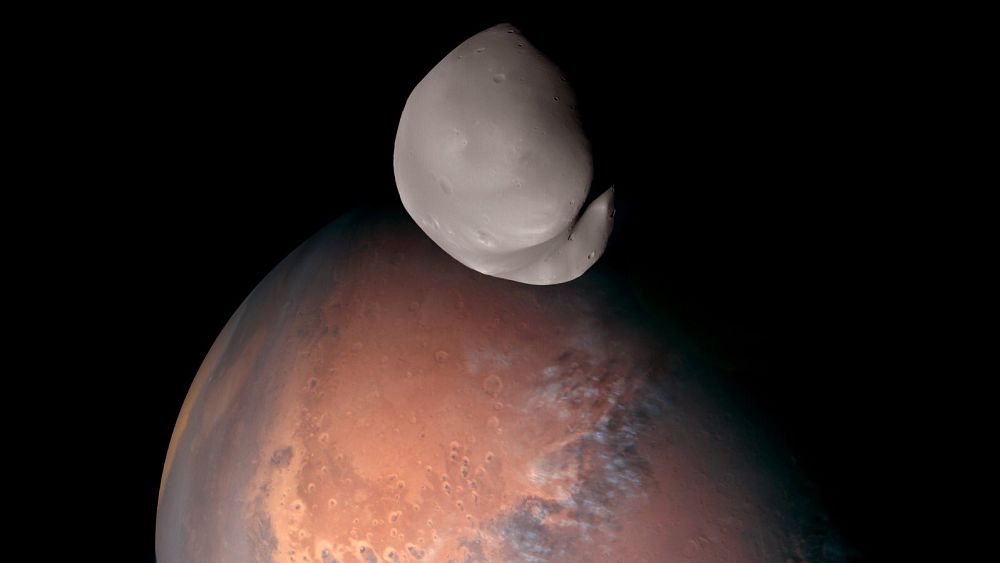
A spacecraft orbiting Mars has sent back the most detailed photos yet of the planet’s tiny moon Deimos - and the close-ups have unveiled a new theory about its origins.
The United Arab Emirates' Amal spacecraft flew within 100 km of Deimos last month taking close-up shots that were released on Monday.
Amal - Arabic for Hope - got two-for-one when Mars photobombed some of the images. It was the closest a spacecraft has been to Deimos in almost a half-century.
The spacecraft also observed the little explored far side of the odd-shaped, cratered moon, which has a radius of just 6.2 km.
The new images indicate that Deimos is not an asteroid that was captured by Mars’ gravity aeons ago, according to scientists at the UAE Space Agency.
They say that it shows the moon appears to be of Martian origin - perhaps from the planet itself, or from Mars’ other, much larger moon.
"We are not sure of the origins of Phobos and Deimos," said Hessa Al Matroushi, the EMM mission's chief scientist, in a statement.
"A long-held theory is that they are asteroids from the asteroid belt that were ‘captured’ in the Red Planet's orbit, she said. But close observations by the Amal probe point to a planetary origin.
Like its companion Phobos, the celestial body has "infrared properties closer to the basaltic rocks of Mars than to those of the meteorite that fell near Tagish Lake in Canada,often used by analogy to study Phobos and Deimos,” according to Christopher Edwards, one of the scientists behind the Emirates Mars InfraRed Spectrometer (EMIRS) instrument.
The findings were presented on Monday at the European Geosciences Union's general assembly in Vienna.
The Arab world’s first interplanetary mission
The close-up shots of Deimos were taken as part of the UAE’s mission to Mars, which launched in July 2020, reaching Martian orbit in February 2021.
The arrival put the UAE in a league of just five space agencies in history to pull off a functioning Mars mission.
From Martian orbit, it has been surveying the planet’s mostly carbon dioxide atmosphere at all times of day and in all seasons.
It joined six spacecraft already operating around Mars: three from the US, two European, and one Indian.
Mars’ other moon, Phobos, is almost double the size of Deimos, and better understood since it orbits much closer to Mars - just 6,000 km away, the closest of any planet’s moon in our solar system.
Deimos' orbit around Mars stretches 23,000 km out. That's close to the inner part of the spacecraft's orbit - “which is what made observing Deimos such a compelling idea,” said al-Matroushi.
"Phobos has gotten most of the attention up until now - now it’s Deimos’ turn!" she added in an email to the Associated Press.
Amal will continue to sweep past Deimos this year, but not as closely as the March 10 encounter, according to al-Matroushi.
NASA's Viking 2 came within 30 km of Deimos in 1977. Since then, other spacecraft have photographed Deimos but from much farther away.
https://news.google.com/rss/articles/CBMic2h0dHBzOi8vd3d3LmV1cm9uZXdzLmNvbS9uZXh0LzIwMjMvMDQvMjUvc3R1bm5pbmctY2xvc2UtdXAtaW1hZ2VzLW9mLW1hcnMtdGlueS1tb29uLWRlaW1vcy1zcGFya3MtbmV3LW9yaWdpbi10aGVvcnnSAQA?oc=5
2023-04-25 14:57:32Z
1979649328
Tidak ada komentar:
Posting Komentar